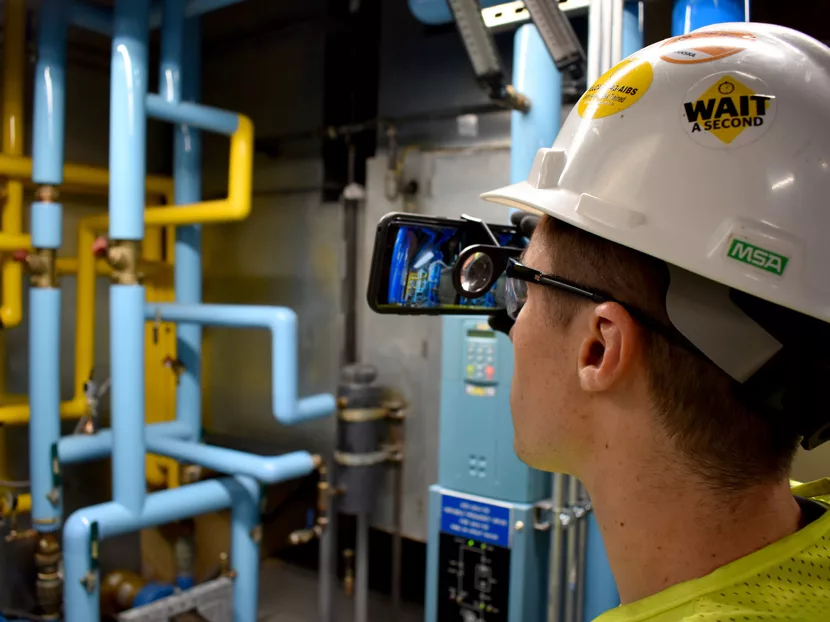Constructing the built environment is getting more and more complex. Building owners and occupants are demanding more options, more technologies and more sustainability.
Luckily, our own technology is advancing to keep pace. Virtual and augmented reality are two emerging examples.
Virtual reality delivers a three-dimensional, computer-generated environment that users can navigate and manipulate.
VR delivers a completely immersive and interactive way for building owners, designers and builders to collaborate. The latest mechanical system designs and construction progress can be mapped out, allowing all parties to resolve and reroute conflicts in real time.
Augmented reality is similar. Instead of an entirely virtual world, AR overlays virtual elements onto the real world in front of you.
It delivers a heads-up display to grant users X-ray-like vision – what structures and mechanical systems are behind the wall in front of you – and even future vision – being able to see where structures and mechanical systems are designed to go.
VR and AR both offer an immense set of opportunities. Many industries have a head start. Aviation, for example, is deploying VR and AR in manufacturing, maintenance, training and even customer service. The construction and mechanical contracting world is learning from these applications with dramatic results:
- Streamline cross-team collaboration, workflow and client engagement.
- Improve our ability to document the life of the buildings.
- Revolutionize the way we train and develop our workforce.
Collaboration
TAE Aerospace, for example, is using VR and AR technologies to allow onsite aviation technicians to collaborate with product experts remotely. The platform uses a real-time audiovisual system that allows the experts to work virtually alongside the technician. The expert sees what the technician sees and can relay guidance to help complete specific tasks.
McKinstry recently used similar technology to commission a wireless network in a newly constructed building using two different employees in two different states. The senior engineer who designed the system was based in Seattle, while the building was located in Denver. Schedules and budgets didn’t allow for extensive travel back and forth. AR offered a workaround.
A McKinstry junior engineer donned a pair of AR glasses on the physical job site. Sitting in his office in Seattle, the senior engineer was able to see exactly what the junior engineer saw, walking him through the building and calling out what equipment to look for, what tests to run, and what changes to make.
The project was completed flawlessly, on time and on budget thanks to the flexibility provided by emerging AR technologies.
Holobuilder and other vendors are taking these concepts further, creating applications that allow project teams to see construction sites in a completely immersive 360-degree virtual world. Workers can work side-by-side in a virtual version of the building, pulling up schematics and specifications to map out each project phase.
Meanwhile, DAQRI is working to deliver heads-up AR displays built into hard hats. Workers can pull up and follow step-by-step construction guides to outline work that needs to be performed.
The technology lays out a virtual template that workers can follow as they construct mechanical systems, streamlining workflow dramatically. DAQRI has several demonstration videos posted online to help paint what’s possible for our industry.
Just as AR and VR are streamlining cross-team collaboration and workflow, it’s also increasing our ability to engage building owners and designers.
Paper diagrams and computer models can take you only so far. Creating a completely immersive three-dimensional environment brings the project to life, allowing clients to experience the project like never before possible.
Documentation
Air New Zealand and Dimension Data are beta-testing Microsoft HoloLens applications for its cabin crews. Flight attendees wearing the HoloLens can display information on the headset to record flight details, passenger information, time since last service and even the emotional state of individual passengers.
Construction and facility services can benefit from this same application. Imagine walking through a building’s mechanical room wearing AR glasses. Hot spots on individual systems and equipment flag critical information like make and model, user and service instructions, warranty data, time until the next scheduled maintenance and a record of the last maintenance incident. The entire life of the building would be documented and available on demand.
McKinstry recently announced a strategic partnership with Visual Vocal to explore AR and VR applications with a keen eye toward these types of facility operations and maintenance services.
The Visual Vocal platform creates immersive AR and VR environments that can be displayed on standard smartphones, tablets and other mobile devices. Project teams can leverage the AR and VR capabilities to stage, mark up and vocally annotate work performed.
Since Visual Vocal works on mobile devices, the platform can be deployed easily across service fleets, allowing technicians to create AR and VR files while in the field, on the jobsite or meeting with clients and partners.
Records management and equipment transitions are two of the biggest issues facing facility operations and maintenance. Architects design the building and then hand the project over to builders. After construction, the building is transitioned to building owners and managers to operate and maintain with assistance from a separate services firm.
A lot of the details get lost in these transitions, especially since each stakeholder uses his or her own software applications and file types.
Visual Vocal can integrate the disparate process into a single platform. Architects will deliver designs in AR and VR, which can then be added to and annotated by the builder during the construction process.
After transition, the building owner and operator will receive a virtual owner’s manual for the building. Facility technicians can then add maintenance requirements and records. After the job is done, the records would be updated to ensure all future technicians have the most current information and maintenance records.
The ultimate goal is to create a single resource for the life of the building.
Workforce training and development
Technology is advancing rapidly. The rate of change is so rapid that educators agree that the ability to gain new knowledge will soon be more valuable than the knowledge itself.
We’re about to experience the rise of “in the moment” training and workforce development with help from AR and VR technologies.
United Technologies Research Center partnered with Pratt & Whitney to create VR engine maintenance training for airline mechanics. Headsets and hand sensor controls allow mechanics to walk inside an engine virtually to examine parts. The virtual engine can even be viewed from the inside while running. Japan Airlines is developing similar capabilities using Microsoft’s HoloLens.
McKinstry, and the rest of the construction industry, is facing a tremendous workforce issue. AR and VR training systems can help face that gap head on. Well-trained, veteran workers can be centralized, guiding the new workers via AR and VR in the moment as projects advance.
The examples provided in each section of this article demonstrate how AR and VR will be used to walk new workers through construction best practices and training sessions while on the job.
Workers just need to learn how to use the digital reality hardware, and they will be prepared for fieldwork. Less time will be spent in off-site training so productivity increases.
Construction and mechanical contracting is changing rapidly, getting more-and-more complex. Virtual and augmented reality can help our workforce keep pace now and well into the future. It won’t be long until these technologies become standard on every project. Be ready






